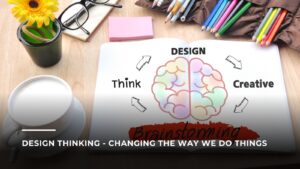While you may perceive the term design-thinking to connect with products or digital artwork, it has evolved over the years, and today it holds great meaning for future leaders and innovators.
Design thinking is an ideology and structured process to ideate innovative solutions from a user-centric approach and then test those innovations/ ideas, understand the findings and update accordingly. This iterative process helps resolve many challenges and issues with viable, feasible and desirable solutions. With this new approach focusing on the users, many aspects of our life will experience a paradigm-shifting thought and experimentation process.
We’ve always focused on finding a winning solution to any problem, but design thinking entirely changes our process and understanding. It teaches us to:
Ask questions
It encourages us to ask questions in every situation leading us to creative ideas, solutions and suggestions. For instance – I’ve learnt something new, so what can I create with it, or where can I use it? How can I evolve this thought into something better? These questions change how we perceive things and activate our imagination to ideate better solutions.
Understand the problems
Often we look at an issue or problem and jump to the common solution without considering its impact or dismiss the challenge saying it’s out of our hands. It’s important to empathize with the human aspect of it before responding or giving in. For instance – before launching bamboo plates in the market, you may want to understand who would be willing to use them, what kind of impact they will have in the community, and whether the cost of the plates is reasonable for consumers.
This way, we’re thinking from the user’s perspective, being empathetic and then putting together an idea.
Convince with tools
We’ve all seen clients reject ideas upon hearing them since they couldn’t visualize them properly. The design thinking process involves creating prototypes to get feedback or response from the said users. This step helps persuade the said users to approve the idea after catching a glimpse of the prototype and sharing their thoughts. Many innovative ideas can float through this process instead of being shot down due to limitations.
Collaborate towards change
There are so many moments when leaders have accelerated an idea but received backlash or demand for tweaks. Such situations occur when people or users are not involved in a big change. But the design thinking process tells us to empathize and understand, requiring innovators/leaders to often talk or collaborate with the people to understand their challenges and get their input on your future ideas. It makes people feel like they’ve been a part of the decision, and who knows, you may end up finding out something substantial to add to your idea.
Innovate everywhere
Once every individual learns the design thinking process, it’s hard to do things the same way. Then, we start to become creative with every daily process and try to evolve it. For instance – while cooking, you may think, what should I add to this dish which may seem new and tastier to the guests? Or how can I make this healthier and as delicious?

